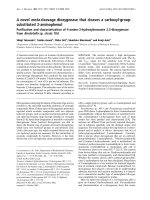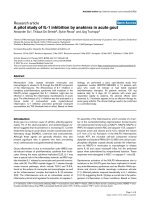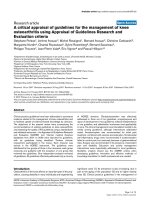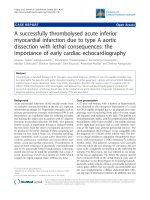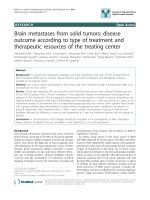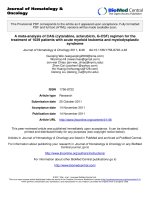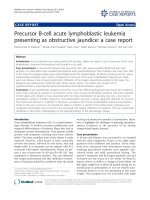Báo cáo y học: "A successfully thrombolysed acute inferior myocardial infarction due to type A aortic dissection with lethal consequences: the importance of early cardiac echocardiography" ppsx
Bạn đang xem bản rút gọn của tài liệu. Xem và tải ngay bản đầy đủ của tài liệu tại đây (1.4 MB, 6 trang )
CAS E REP O R T Open Access
A successfully thrombolysed acute inferior
myocardial infarction due to type A aortic
dissection with lethal consequences: the
importance of early cardiac echocardiography
Grigorios Tsigkas
1
, Georgios Kasimis
1*
, Konstantinos Theodoropoulos
1
, Konstantinos Chouchoulis
1
,
Nikolaos G Baikoussis
2
, Efstratios Apostolakis
2
, Eleni Bousoula
1
, Athanasios Moulias
1
and Dimitrios Alexopoulos
1
Abstract
Thrombolysis, a standard therapy for ST elevation myocardial infarction (STEMI) in non-PCI-capable hospitals, may
be catastrophic for patients with aortic dissection leading to further expansion, rupture and uncontrolled bleeding.
Stanford type A aortic dissection, rarely may mimic myocardial infarction. We report a case of a patient with an
inferior STEMI thrombolysed with tenecteplase and followed by clinical and electrocardiographic evidence of
successful reperfusion, which was found later to be a lethal acute aortic dissection. Prognostic implications of early
diagnosis applying transthoracic echocardiography (TTE) are described.
Background
Acute myocardial infarction (AMI) usually results from
an occlusive coronary thrombus at the site of a ruptured
atherosclerotic plaque [1]. Reperfusion therapies such as
primary percutaneo us coronar y intervent ion (PPCI) and
thrombolysis are mandatory steps for reducing mortality
and limiting the infarct size in patients with ST segment
elevation myocardial infarction (STEMI). The greatest
benefit occurs, if reperfusion therapy is initi ated within
the first hours from the onset of symptoms and there is
no preference for either strategy, if these symptoms are
present for less than 3 hours [2]. Clinically speaking,
many conditions, such as acute aortic dissection, peri-
carditis, pulmonary embolism and myocarditis may
mimic acute myocardial infarction. Thrombolysis in
most of these situations is absolutely contraindicated
due to its potentially lethal complications. Clinicians
should always bear in mind the possibility that a type A
aortic dissection (AAD) may mimic an AMI, which
requires an urgent surgical repair without any delay.
Case presentation
A 57-year-old wo man, with a history of hypertension,
was admitted to the emergency department of a rural
non-PCI-capable Hos pit al due to an atypical, non-com-
pressing, non-excruciating chest pain of recent origin
(30 minutes) with radiation to the back. The patient was
hemodynamically stable, with no peripheral pulse deficit.
Auscultation of the heart revealed a 2/6 systolic murmur
at the r ight base and apex and an early diastolic mur-
mur at the right base without pericardial friction. The
electrocardiogram (ECG) (Figure 1) was compatible with
the diagnosis of a STEMI of the inferior wall. The doc-
tor in charge decided to administer thrombolytic treat-
ment with tenecteplase (TNK) (Metalyse
®
) without
further delay. The patient’ s symptoms were partially
relieved, while the pre-existing ST elevation did not
seem to be completely normalized in the following 60
minutes. For this reason, she was referred to our hospi-
tal for rescue angioplasty [3]. When the patient arrived
had a remission both of the initial thoracic pain a nd of
ST-elevation in the ECG (Figure 2), remaining hemody-
namically stable without obvious perceivable peripheral
artery pulse deficit, but was clearly uncomfortable and
she was complaining for a diffuse abdominal pain with-
out any sign of peritoneal irritation. In addition, she was
* Correspondence:
1
Department of Cardiology, Patras University School of Medicine , Patras,
Greece
Full list of author information is available at the end of the article
Tsigkas et al. Journal of Cardiothoracic Surgery 2011, 6:101
/>© 2011 Tsigkas et al; license e BioMed Central Ltd. This is a n Open Access article distributed unde r the terms of the Creative Comm ons
Attribution License ( which permits unrestricted use, distribution, and reprod uction in
any medium, provided the original work is properly cited.
anuric during the whole time of her transport, namely
about 3 hours. Blood sample a nalysis showed: Hct 37%,
WBC 14,600/ μL, PMN 86%, Ur 70 m g/dl, Cr 1.3 mg/dl,
SGOT 63 U/L, CPK 483 U/L, TNI 2.1 ng/ml. A bedside
chest x-ray was not diagnostic, while a quick bedside
transthoracic echocardiography (TTE) revealed severe
hypokinesia of the posterior and the inferior wall and a
dilated aorta with a high suspicion of an intimal dissec-
tion flap (Figure 3a). Color flow Doppler showed moder-
ate aortic and mild mitral regurgitation (Figure 3b).
AAD complicated with an inferior AMI was highly sus-
pected. The following Multidetector Computed
Figure 1 The initial electrocardiogram (ECG): ECG shows sinus rhythm with ST elevation in leads II, III, aVF and reciprocal changes in I,
aVL.
Figure 2 Post thrombolysis ECG: ECG at our ED, with sinus rhythm, Q and negative T waves at the inferior leads, premature a trial
contractions and non specific secondary changes of ST at the lateral wall.
Tsigkas et al. Journal of Cardiothoracic Surgery 2011, 6:101
/>Page 2 of 6
Tomography Angiography (MDCTA) confirmed the
extended dissection from the ascending aorta to the iliac
arteries (Figure 4 and 5). Cardia c surgeons were imme-
diately informed and an emergent replacement of the
aortic root and ascending aorta was decided. The patient
was transported in the operating room in a critical state.
The right axillary artery was cannulated before sternot-
omy. Then, a median sternotomy was performed and
the pericardium was opened. A dilated ascending aorta,
clots in the pericardium, dilatation of the right cardiac
chambers due to infarction and a sub-epicardial
hematoma along the right coronary artery in the atrio-
ventricular groove were found. The right atrium was
cannulated, the distal aorta was cross clamped and cold
blood-crystalloid (4/1) cardioplegia was administrated
initially retrograde via the coronary sinus and then ante-
rograde via the left main coronary artery. The procedure
took place under systematic hypothermia (25°C) After
the opening of the aorta the diagnosis of a type A aortic
dissection was confirmed with the implication of the
right coronary artery for its first 5 mm (Figure 6). A
rare finding was the real transection -disruption of the
right coronary artery; the cause of the a cute myocardial
infarction (Figure 7). A Bentall procedure was per-
formed with the implantation of a valved-graft. A coron-
ary artery bypass grafting with a saphenous vein graft
anastomosed in the right coronary artery at the level of
the crux was also done. The patient was re warmed and
weaned successfully from the cardiopulmonary bypass.
Unfortunately, the patient died 48 hours after the opera-
tion because of multiple organ failure.
Discussion
Thrombolysis is currently recommended for patients
with STEMI presenting in non-PCI-capable centers,
especially when PCI in less than 2 h transfer is not pos-
sible [2]. Patients with similar symptoms, but without
myocardial infarction, may be falsely treated with
thrombolysis. Acute ascending aortic dissection asso-
ciated with AMI is rare, with a reported incidence of 1
to 2% [4]. In previous reports [5,6], most patients with
aortic dissection, who were treated with thrombolytic
agents died due to hemorrhagic complications. The
non-invasive identification of successful fibrinolysis
remains a challenging issue, using pain cessation and
Figure 3 Transthoracic echocardiography (TTE): Panel A depicts long axis parasternal view with a dilated aortic root of 4.57 cm,
without pericardial effusion. Panel B the use of Color Flow Doppler unveiled a moderate aortic and mild mitral regurgitation.
Figure 4 Multidetector Computed Tomography Angiography
(MDCTA): Axial plane demonstrates an intimal flap that
separates the false (F) from the true lumen (T) in the
ascending and descending aorta, diagnostic of a Stanford type
A dissection.
Tsigkas et al. Journal of Cardiothoracic Surgery 2011, 6:101
/>Page 3 of 6
more than 50 per cent ST-segment resolution in the
lead(s) with the highest ST-segment elevations 60 to 90
minutes after initiation of fibrinolytic therapy as a useful
surrogate [3]. Although, the primary event, which
caused AMI was aortic dissection, two hypotheses may
expl ain the coronary occlusio n. Since the dissection can
partially occlude the ostium of a coronary artery, it can
modifythebloodflowandpressureinsidethevessel,
leading to coronary thrombosis and consequent myocar-
dial infarction. Tenekteplase, by dissolving the thrombi
through the false lumen of the coronary artery and aor-
tic root, allowed reperfusion, but later led to further
bleeding and occlusion [7]. Another possibility is that a
coronary spasm was the cause of the STEMI, due to
nearby hematoma or pressure of the false lumen which
resolved with the use of the adjuvant therapy, such as
nitrat es. The followed inappr opriate thrombolysis prob-
ably affected adversely the outcome by being the causa-
tive factor for the further expansion of the tear and by
causing difficulties with the hemostasis at the surgery
[8,9]. Aortic dissection is caused by an intimal tear fol-
lowing elastic degeneration, smooth muscle cells loss or
elevated pressure in vasa vasorum, which leads to rup-
ture and allows the creation of a false lumen between
the media and adventitia [10].Thepresenceofsevere
chest pain of very sudden onset, usually described as
tearing and followed from a feeling of impend ing death,
a discrepancy in the pulse or blood pressure in the two
upper extremities or between upper a nd lower extremi-
ties and a widening of mediastinal on chest X-ray are
reported to have a probability of 96% for the diagnosis
of AAD. On the other hand, if those signs are not pre-
sent, the probability of AAD is only 7% [11]. Sometimes
is difficult to distinguish AAD from angina pectoris.
Other common presentations for type A dissections
include syncope (13% of type A AADs) and abdominal
pain (22% of type A AADs and 43% of type B AADs).
The above symptoms have important prognostic impli-
cations, signaling increased risks for shock, ischemia or
infarctio n complications of mesenteric and limb arter ies
Figure 5 Multidetector Computed Tomography Angiography
(MDCTA): Median plane depicts the extended dissection from
the ascending aorta, passing through the origins of celiac
trunk (black arrow) and superior mesenteric artery (arrow
head) down to the iliac arteries (white arrow).
Figure 6 During operation: The origin of the right coronary
artery from the false lumen (black arrow), the false lumen
(white arrow), the intimal flap (arrow head) and the venous
cannula inserted in the right atrium are seen (asterisk).
Tsigkas et al. Journal of Cardiothoracic Surgery 2011, 6:101
/>Page 4 of 6
and in-hospital mortality, mainly because of delay in
diagnosis [12]. Most of the patients with AAD, about
75%, have a history of hypertension [13]. Aortic dissec-
tion is less common than myocardial infarction and its
association with ST segment elevation is unusual
[14,15]. This combination can be recognized early with
the help of diagnostic imaging, minimizing the risk of
thrombolysis in selected patients. Bedside chest X-ray is
not sufficient to rule out aortic dissection, but a great
percentage of patients with AAD have an abnormal one,
often showing a distended aorta or generalized widening
of the mediastinum [16]. Transthoracic followed by
transesophageal echocardiography (TEE), MDCTA and
Magnetic Resonance Imaging (MRI) are very important
and essential imaging tools with high sensitivity and
speci ficity for early life-saving diagnosis of aortic dissec-
tion [4]. The TTE is of great importance because it is
an easy, non-invasive, widely available and minimally
time consuming technique, which can play a major role
in differential diagnosis in emergency department. It can
provide much information about possible aortic dilation
and insufficiency of the aortic valve, pericardial and/or
pleural effusion an d finally about a disse ction flap,
which is the hallmark for the diagnosis of the aortic dis-
section. Despite that a remarkable improvement in
developm ent of new biomarkers has been made, there is
no widely accepted strategy in this field. The biochem-
ical diagnosis of aortic dissection has become possible
by identifying raised concentrations of smooth muscle
myosin heavy ch ain [17]. More recently, widely available
biomarkers, such as D-dimer are thought to play an
assistive role [ 18]. Our knowledge for the identification
and the manag ement of acut eaorticpathologyhas
made a tremendously improvement, mainly due to
International Registry of Acute Aortic Dissection
(IRAD). It is now known that if type A AAD remains
untreated, one third of patients die within the f irst 24
hours, and the half of them die within 48 hours.
According to latest data, surgery is the best option with
a mortality rate of 5 to 21% for type A AAD and medi-
cation only is the best choice for an uncomplicated type
B AAD with a mortality rate of approximately 20% [19].
Conclusions
Thrombolytic treatment for STEMI, whenever PCI is
not available, should not be postponed, except in cases
of suspected aortic dissection. Our case shows that even
clinical and electrocardiographic signs of successful
reperfusion can occur when aortic dissection is the pri-
mary cause of the myocardial infarction. The presence
of eccentric aortic regurgitation, the dilated ascending
aorta and the possible visualization of double lumen by
TTE could provide strong hints of the coexistence of
AMI and type A aortic dissection. In conclusion, if aor-
tic dissection is suspected, arrangement of the appropri-
ate imaging studies should be done without fu rther
delay. Hence, bedside TTE can help as it is an easy, safe
and rapid procedure to diagnose proximal aortic dissec-
tion without crucial delay. Cardiologists should bear in
mind this usually lethal complication of acute aortic dis-
section and perform TTE prior to catheterization and
even more before fibrinolysis.
Consent
Written informed consent was obtained from the next
of kin of the deceased patient for publication of this
case report and the accompanying images. A copy of
the written consent is available for review by the Editor-
in-Chief of this journal.
Author details
1
Department of Cardiology, Patras University School of Medicine , Patras,
Greece.
2
Department of Cardiothoracic Surgery, Patras University School of
Medicine, Patras, Greece.
Authors’ contributions
GT has made substantial contributions to conception and design, has been
involved in drafting the manuscript and revising it critically for important
intellectual content, GK has been involved in drafting the manuscript, KT
carried out the echocardiogram studies and has made substantial
contributions of data analysis, KC has made substantial contributions to
conception and design of the manuscript, NB participated in the operation,
Figure 7 During operation: A real transection of the right
coronary artery (black arrow) is shown. A dissector was passed
through the coronary ostium till the side of its rupture.
Tsigkas et al. Journal of Cardiothoracic Surgery 2011, 6:101
/>Page 5 of 6
EA performed the operation, EB has been involved in interpretation of
echocardiogram and has made substantial contributions of data analysis, AM
has made substantial contributions to design the manuscript and DA has
made substantial contribution to design and has given the final approval of
the version to be published. All authors read and approved the final
manuscript.
Competing interests
The authors declare that they have no competing interests.
Received: 27 March 2011 Accepted: 24 August 2011
Published: 24 August 2011
References
1. Hennekens CH, O’Donnell CJ, Ridker PM, Marder VJ: Current issues
concerning thrombolytic therapy for acute myocardial infarction. JAm
Coll Cardiol 1995, 25(7 Suppl):18S-22S.
2. The Task Force on Myocardial Revascularization of the European Society of
Cardiology (ESC) and the European Association for Cardio-Thoracic Surgery
(EACTS, European Association for Percutaneous Cardiovascular Interventions
(EAPCI), Kolh P, Wijns W, Danchin N, Di Mario C, Falk V, Folliguet T, Garg S,
Huber K, James S, Knuuti J, Lopez-Sendon J, Marco J, Menicanti L,
Ostojic M, Piepoli MF, Pirlet C, Pomar JL, Reifart N, Ribichini FL, Schalij MJ,
Sergeant P, Serruys PW, Silber S, Sousa Uva M, Taggart D: Guidelines on
myocardial revascularization. European Heart Journal 2010, 31:2501-2555.
3. Task Force on the management of ST-segment elevation acute myocardial
infarction, Van de Werf F, Bax J, Betriu A, Blomstrom-Lundqvist C, Crea F,
Falk V, Filippatos G, Fox K, Huber K, Kastrati A, Rosengren A, Steg PG,
Tubaro M, Verheugt F, Weidinger F, Weis M: ESC guidelines on
management of acute myocardial infarction in patients presenting with
persistent ST-segment elevation. Rev Esp Cardiol 2009, 62(3):293, e1-47.
4. Erbel R, Alfonso F, Boileau C, Dirsch O, Eber B, Haverich A, Rakowski H,
Struyven J, Radegran K, Sechtem U, Taylor J, Zollikofer Ch, Internal
reviewers, Klein WW, Mulder B, Providencia LA: Recommendations of the
Task Force on Aortic Dissection, European Society of Cardiology.
European Heart Journal 2001, 22:1642-1681.
5. Blankenship JC, Almquist AK: Cardiovascular complications of
thrombolytic therapy in patients with a mistaken diagnosis of acute
myocardial infarction. J Am Coll Cardiol 1989, 14:1579-1582.
6. Eriksen UH, Mølgaard H, Ingerslev J, Nielsen TT: Fatal haemostatic
complications due to thrombolytic therapy in patients falsely diagnosed
as acute myocardial infarction. Eur Heart J 1992, 13:840-843.
7. Safi J Jr, Mansur AJ, Brito FS Jr, Benvenuti LA, Ratti MA, Ramires JA:
Regression of ST segment elevation after thrombolysis in acute aortic
dissection. South Med J 1996, 89:1091-3.
8. Neri E, Toscano T, Papalia U, Frati G, Massetti M, Capannini G, Tucci E,
Buklas D, Muzzi L, Oricchio L, Sassi C: Proximal aortic dissection with
coronary malperfusion: presentation, management and outcome. CJ
Thorac Cardiovascular Surg 2001, 121:552-60.
9. Kawahito K, Adachi H, Murata S, Yamaguchi A, Ino T: Coronary
malperfusion due to type A aortic dissection: Mechanism and surgical
management. Ann Thorac Surg 2003, 76:1471-6.
10. Erbel R, Alfonso F, Boileau C, Dirsch O, Eber B, Haverich A, Rakowski H,
Struyven J, Radegran K, Sechtem U, Taylor J, Zollikofer C, Klein WW,
Mulder B, Providencia LA, Task Force on Aortic Dissection, European Society
of Cardiology: Diagnosis and management of aortic dissection. Eur Heart
J 2001, 22(18):1642-81.
11. Sullivan P, Wolfson A, Leckey R, Burke J: Diagnosis of acute thoracic aortic
dissection in the emergency department. The American Journal of
Emergency Medicine1 2000, 18(1):46-50.
12. Ramanath VS, Oh JK, Sundt TM, Eagle KA: Acute aortic syndromes and
thoracic aortic aneurysm. Mayo Clin Proc 2009, 84(5):465-81.
13. Mészáros I, Mórocz J, Szlávi J, Schmidt J, Tornóci L, Nagy L, Szép L:
Epidemiology and clinicopathology of aortic dissection.
Chest 2000,
117(5):1271-8.
14. Weiss P, Weiss I, Zuber M, Ritz R: How many patients with acute
dissection of the thoracic aorta would erroneously receive thrombolytic
therapy based on the electrocardiographic findings on admission? Am J
Cardiol 1993, 72:1329-1330.
15. Kamp TJ, Goldschmidt-Clermont PJ, Brinker JA, Resar JR: Myocardial
infarction, aortic dissection, and thrombolytic therapy. Am Heart J 1994,
128:1234-7.
16. Hartnell GG, Wakeley CJ, Tottle A, Papouchado M, Wilde RP: Limitations of
chest radiography in discriminating between aortic dissection and
myocardial infarction: implications for thrombolysis. J Thorac Imaging
1993, 8:152-5.
17. Suzuki T, Katoh H, Watanabe M, Kurabayashi M, Hiramori K, Hori S,
Nobuyoshi M, Tanaka H, Kodama K, Sato H, Suzuki S, Tsuchio Y, Yazaki Y,
Nagai R: Novel biochemical diagnostic method for aortic dissection.
Results of a prospective study using an immunoassay of smooth muscle
myosin heavy chain. Circulation 1996, 93:1244-9.
18. Suzuki T, Distante A, Zizza A, Trimarchi S, Villani M, Salerno Uriarte JA, De
Luca Tupputi Schinosa L, Renzulli A, Sabino F, Nowak R, Birkhahn R,
Hollander JE, Counselman F, Vijayendran R, Bossone E, Eagle K, IRAD-Bio
Investigators: Diagnosis of acute aortic dissection by D-dimer: the
International Registry of Acute Aortic Dissection Substudy on Biomarkers
(IRAD-Bio) experience. Circulation 2009, 119:2702-7.
19. Nienaber CA, Fattori R, Mehta RH, Richartz BM, Evangelista A, Petzsch M,
Cooper JV, Januzzi JL, Ince H, Sechtem U, Bossone E, Fang J, Smith DE,
Isselbacher EM, Pape LA, Eagle KA: International Registry of Acute Aortic
Dissection. Gender-related differences in acute aortic dissection.
Circulation 2004, 109(24):3014-21.
doi:10.1186/1749-8090-6-101
Cite this article as: Tsigkas et al.: A successfully thrombolysed acute
inferior myocardial infarction due to type A aortic dissection with lethal
consequences: the importance of early cardiac echocardiography.
Journal of Cardiothoracic Surgery 2011 6:101.
Submit your next manuscript to BioMed Central
and take full advantage of:
• Convenient online submission
• Thorough peer review
• No space constraints or color figure charges
• Immediate publication on acceptance
• Inclusion in PubMed, CAS, Scopus and Google Scholar
• Research which is freely available for redistribution
Submit your manuscript at
www.biomedcentral.com/submit
Tsigkas et al. Journal of Cardiothoracic Surgery 2011, 6:101
/>Page 6 of 6
